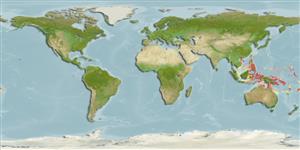Classification / Names
Common names from other countries
Main reference
Size / Weight / Age
Max length : 121 cm TL male/unsexed; (Ref. 33408)
Environment
Marine; demersal; depth range 5 - 20 m (Ref. 90102)
Climate / Range
Tropical, preferred ?
Distribution
Short description
Dorsal
soft rays
(total): 616-617;
Anal
soft rays: 407 - 409;
Vertebrae: 201 - 219. This species slender, elongated, with the depth at the gills 1.1-1.6% of total length; a short head length, 11.2-14.1% of snout-anus length; mouth, as measured by front of upper jaw to rictus, is greater than 3.6% of snout-anus length; head pores are POM 5+4 and ST 2+1 (Ref. 58269).
IUCN Red List Status (Ref. 115185)
Threat to humans
Harmless
Human uses
More information
Common namesSynonymsMetabolismPredatorsEcotoxicologyReproductionMaturitySpawningFecundityEggsEgg development
Age/SizeGrowthLength-weightLength-lengthLength-frequenciesMorphometricsMorphologyLarvaeLarval dynamicsRecruitmentAbundance
ReferencesAquacultureAquaculture profileStrainsGeneticsAllele frequenciesHeritabilityDiseasesProcessingMass conversion
Tools
Special reports
Download XML
Internet sources
Estimates of some properties based on models
Phylogenetic diversity index
PD50 = 0.5001 many relatives (e.g. carps) 0.5 - 2.0 few relatives (e.g. lungfishes)
Trophic Level
3.5 ±0.5 se; Based on size and trophs of closest relatives
Resilience
Low, minimum population doubling time 4.5 - 14 years (Preliminary K or Fecundity.)
Vulnerability
High to very high vulnerability (65 of 100)
Price category
